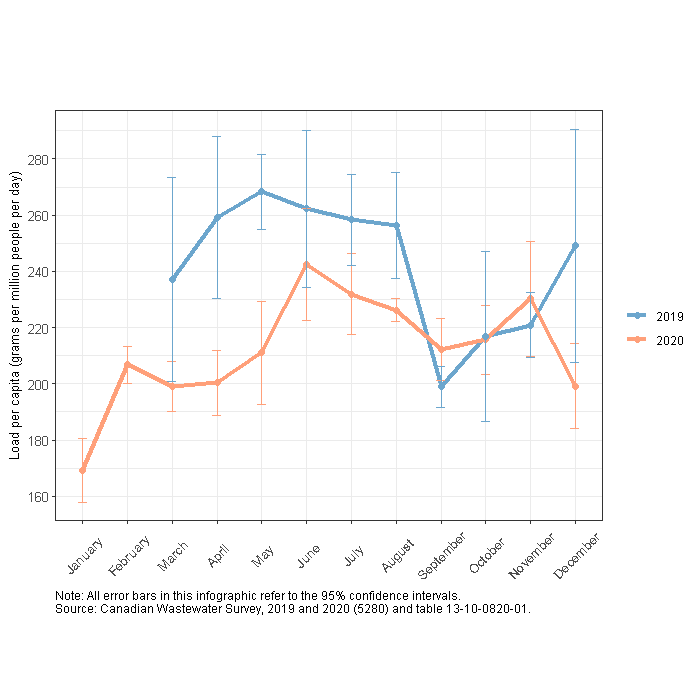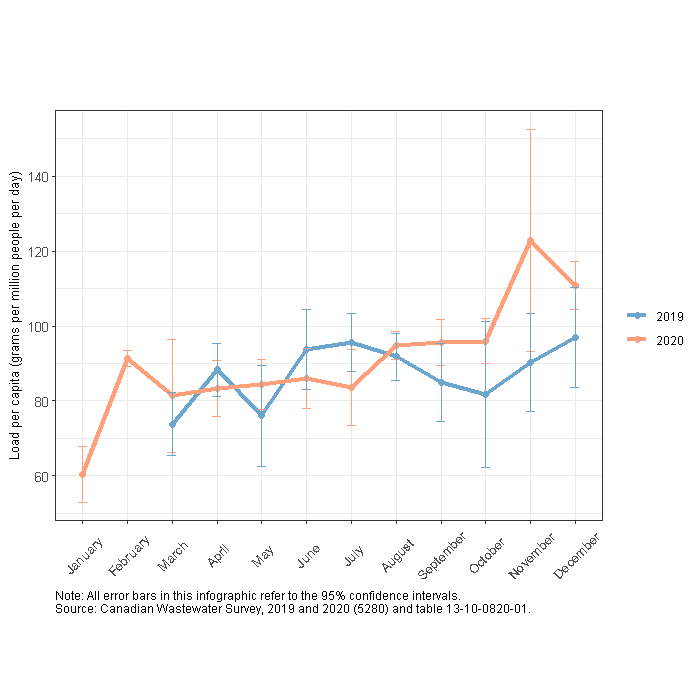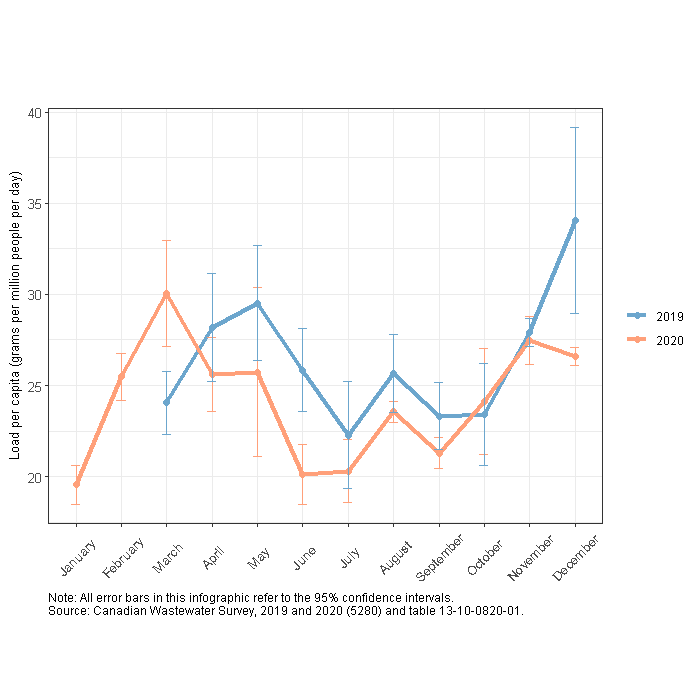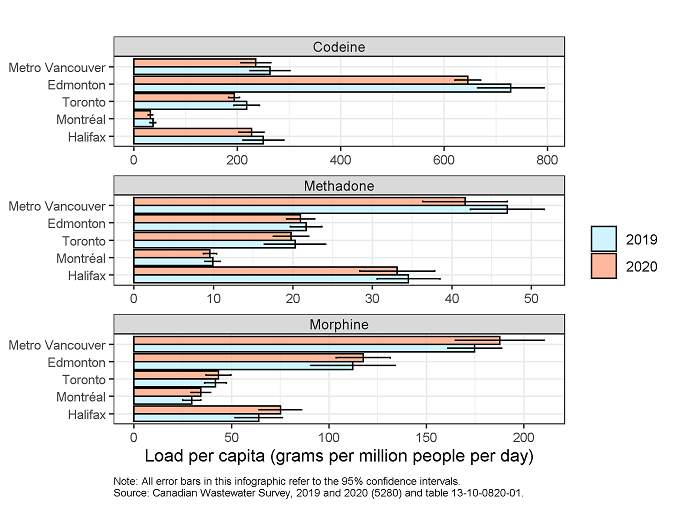Wastewater analysis suggests that use of particular opioid pain medications decreased during the COVID-19 pandemic in 2020
Archived Content
Information identified as archived is provided for reference, research or recordkeeping purposes. It is not subject to the Government of Canada Web Standards and has not been altered or updated since it was archived. Please "contact us" to request a format other than those available.
Released: 2022-03-09
Following our July 2021 release that focused on fentanyl, cannabis, and methamphetamine, new results from Statistics Canada's Canadian Wastewater Survey (CWS) indicate that the load of morphine or methadone did not differ significantly in wastewater from 2019 to 2020. In contrast, codeine load appears to have decreased over the same period.
The cancellation of thousands of surgeries during the COVID-19 pandemic may have contributed to changes in the load of certain opioid pain medication prescribed post-operatively. Changes made to drug regulations in British Columbia for codeine prescriptions (so that they are less susceptible to forgeries) may also be a contributing factor to changes in the measured load of the drug in that province. Additionally, public health restrictions including physical distancing and mask wearing may have reduced respiratory virus transmission resulting in lower use of cold/flu medications containing codeine.
The CWS has been testing wastewater samples from various wastewater treatment plants in five cities across Canada (Halifax, Montréal, Toronto, Edmonton, and Metro Vancouver) since March 2019. Analyses of wastewater samples produce estimates of the amount of a given drug metabolite (a chemical made when the body breaks down a drug) entering the wastewater system, which is generally expected to reflect the overall quantity of the drug consumed by the population within a geographical area (the sewershed catchment).
The focus of this Daily article is on over-the-counter or prescription opioids (codeine, methadone and morphine) which are used as pain medication, and can also be found in cough suppressants and psychoactive drugs. The latest CWS data provide monthly estimates of drugs and their metabolites in wastewater for 14 drugs of concern based on samples collected from August to December 2019 and from August to December 2020. The estimates are based on the amount of drug measured in wastewater (i.e., grams) and presented on a load per capita basis, per day, or levels.
Use of opioid medications during the COVID-19 pandemic
Codeine is an opioid used as a prescription painkiller medication for relief from mild to moderate pain, including post-operative pain. Codeine can also be used to reduce coughing. Products containing codeine (mixed, low dose) are currently available without a prescription (e.g., cold/flu medication). In British Columbia, however, certain prescription-based liquid preparations containing codeine were rescheduled in January 2020 by the College of Pharmacists of British Columbia Board, and now require a special duplicate prescription form, which is designed to prevent forgeries. Statistics Canada's Canadian Community Health Survey found that opioid medications were used by 13% of the population aged 15 and older in 2018, and that medications containing codeine were the most common. Furthermore, roughly 10% of individuals who used an opioid pain medication reported problematic use. Statistics Canada's Provisional death counts and excess mortality show an increase from 2019 to 2020 in deaths caused by unintentional poisonings, including unintentional overdoses due to prescription and over-the-counter medication.
Results from the wastewater show that levels of codeine in wastewater were generally lower in March to August 2020 compared with March to August 2019. Cancellation of surgeries during the pandemic may be a contributing factor in the reduction of codeine measured in wastewater in 2020, which may have reduced the prescription of post-operative medication, including opioid pain medication. The Canadian Institute for Health Information has estimated that from March 2020 to June 2021 there were 560,000 fewer surgeries performed compared with the pre-pandemic period (January to December 2019). Moreover, public health restrictions such as physical distancing and mask wearing may have reduced transmission of other respiratory viruses. For example, the Public Health Agency of Canada's September 2021 FluWatch report declared that influenza detections were significantly lower in the 2020-2021 flu season compared with previous years, with 69 lab-confirmed cases reported in 2020-2021 compared with 55,378 lab-confirmed cases reported in the previous (2019-2020) flu season. This could also have resulted in a decline in the use of codeine-containing cold and flu medications, also influencing codeine levels detected in wastewater.
Unlike codeine, morphine levels in wastewater did not differ significantly from 2019 to 2020. Morphine is a powerful opioid medication used to treat severe and chronic pain. Many opiates produce morphine when metabolized; it is the most abundant metabolite of heroin, codeine and morphine itself. Although morphine is also a drug used for pain management following surgeries, the load of morphine does not appear to have decreased following the cancellation of elective surgeries due to the COVID-19 pandemic; however, it is important to note that many factors can influence drug levels in wastewater. City-to-city comparisons in the next section outline some of the reasons why the level of morphine may not have decreased as much as codeine levels.
Like morphine, methadone levels in wastewater did not change significantly from 2019 to 2020. Methadone is a synthetic opioid used to treat opioid dependence (including heroin, oxycodone and fentanyl) by helping to alleviate withdrawal symptoms and reduce cravings. It has been used for this purpose for around 60 years in Canada, and in 2018, Health Canada announced that practitioners no longer required exemptions to prescribe methadone, allowing for better access to this harm reduction treatment. Although methadone is also a pain killer, its main use is not as a post-operative pain killer, so it was expected that levels would be less influenced by the cancellation of surgeries seen in 2020 due to the COVID-19 pandemic.
Codeine loads highest in Edmonton; morphine and methadone loads highest in Metro Vancouver
Wastewater is a valuable source of information that can be used to monitor drug trends in a city over time. Due to the variability of sewer systems and wastewater treatment plants between cities, caution should be used when making comparisons between cities, especially when differences are small.
Much like the CWS results released in July 2021, different Canadian cities have different drug profiles, including for opioids that are used for medical reasons. Using data from the provincial and territorial offices of the Chief Coroners and Chief Medical Examiners, the Public Health Agency of Canada reported that the crude rate of total apparent opioid toxicity deaths in 2020 was highest in British Columbia, followed by Alberta. In the CWS, codeine loads were highest in Edmonton in both 2019 and 2020, and were more than two times higher than in any other city in both years. However, compared with 2019, there was a decrease in codeine load in Edmonton in 2020, which may have coincided with the cancellation of elective surgeries.
Morphine loads were highest in Metro Vancouver compared with the other cities measured in both 2019 and 2020. One factor contributing to morphine levels detected in wastewater is the consumption of heroin, since a significant metabolite of heroin is morphine. Statistics Canada's dataset on police-reported crimes for selected drug offences, by province or territory, 2020 found that heroin-related offences were highest in British Columbia, which is consistent with the morphine wastewater data.
The highest loads of methadone were observed in Metro Vancouver in both 2019 and 2020. Fentanyl loads were also found to be the highest in Metro Vancouver, so it is possible that the two are correlated since methadone is used as a treatment for opioid addiction, including fentanyl dependence. In general, loads for methadone appear to be stable in Canada for both 2019 and 2020 and there does not appear to be any significant effect on loads due to the pandemic.
Analysis of 2021 CWS samples, as well as ongoing collection, will contribute to a better understanding of the progression and the shifting landscape of drug consumption across Canada during and beyond the pandemic. This could help public health officials, law enforcement agencies and other organizations to adapt their approach and strategies.
Note to readers
Wastewater-based drug epidemiology is a rapidly evolving scientific discipline that applies analytical techniques to wastewater in order to estimate drug usage at the population level. Wastewater analyses complements other indicators of drug use, and has the added advantage of generating near real-time data on geographical and temporal trends.
For this survey, wastewater samples were collected from the influent of 15 wastewater treatment plants (serving close to 8.7 million Canadians) for seven consecutive days during the second week of every month. The daily samples were analyzed at the Health Canada Regulatory Operations and Enforcement Branch laboratory in Toronto. Laboratory results and population estimates for each region were then combined to estimate drug loads per capita in each community.
The table published with this release includes the estimates of weekly load per capita, detection rate, and imputation rate by drug and by municipality for wastewater samples which were collected by the Canadian Wastewater Survey (CWS) from August to December 2019 and from August to December 2020.
Limitations of the Canadian Wastewater Survey
Wastewater-based epidemiology is an inexpensive and powerful tool for estimating community level drug consumption without the need for self-reported drug use surveys. There are, however, some limitations in the analysis and interpretation of estimates from wastewater samples (many of which have been previously described in the report "Wastewater-based Estimates of Cannabis and Drug Use in Canada: Pilot test Detailed Results") and as such, these results should be interpreted with caution. The effects of certain other factors, such as time the samples spent in storage, which may affect the comparability of the results from 2019 to 2020 are currently being investigated. It should also be noted that raw numbers are not comparable to the pilot study due to a change in methodology and analytical labs.
Interpretation of Canadian Wastewater Survey load estimates
It should be noted that some of the measured loads reflect levels of the parent drugs and not the exclusive metabolites. This introduces additional challenges in measuring changes in levels that are strictly due to consumption since it is possible for the load of the drug in wastewater to be elevated due to discharges from drug manufacturing (pharma or dumping).
An additional consideration when interpreting morphine levels in wastewater is that morphine is the metabolite of several other drugs including codeine and heroin. This means levels of morphine in wastewater can be influenced by these drugs, and the levels are not solely an indication of morphine use.
It should be noted that the reduction in the levels of codeine in wastewater may be multi-factorial and it is challenging to attribute the reduction solely to cancellation of surgeries, or implementation of a new regulation.
Interpretation of Montréal load estimates
Drug load estimates for Montréal should be interpreted with caution. Although loads are normalized for wastewater flow and population, the exceptionally low levels of many drugs seen in Montréal wastewater require further investigation.
Contact information
For more information, or to enquire about the concepts, methods or data quality of this release, contact us (toll-free 1-800-263-1136; 514-283-8300; infostats@statcan.gc.ca) or Media Relations (statcan.mediahotline-ligneinfomedias.statcan@statcan.gc.ca).
- Date modified:





